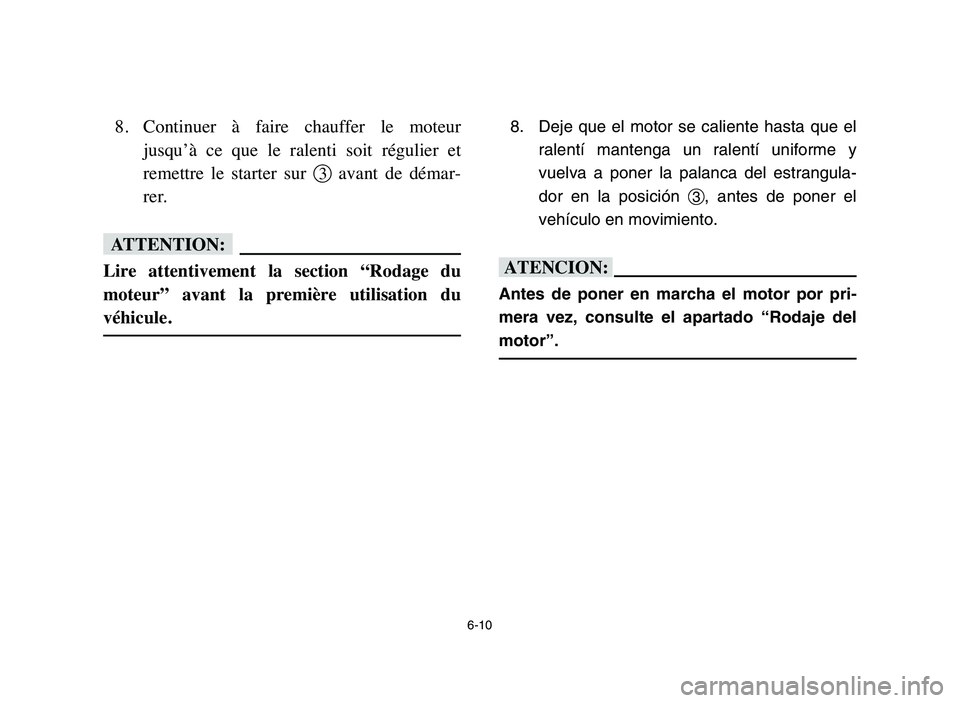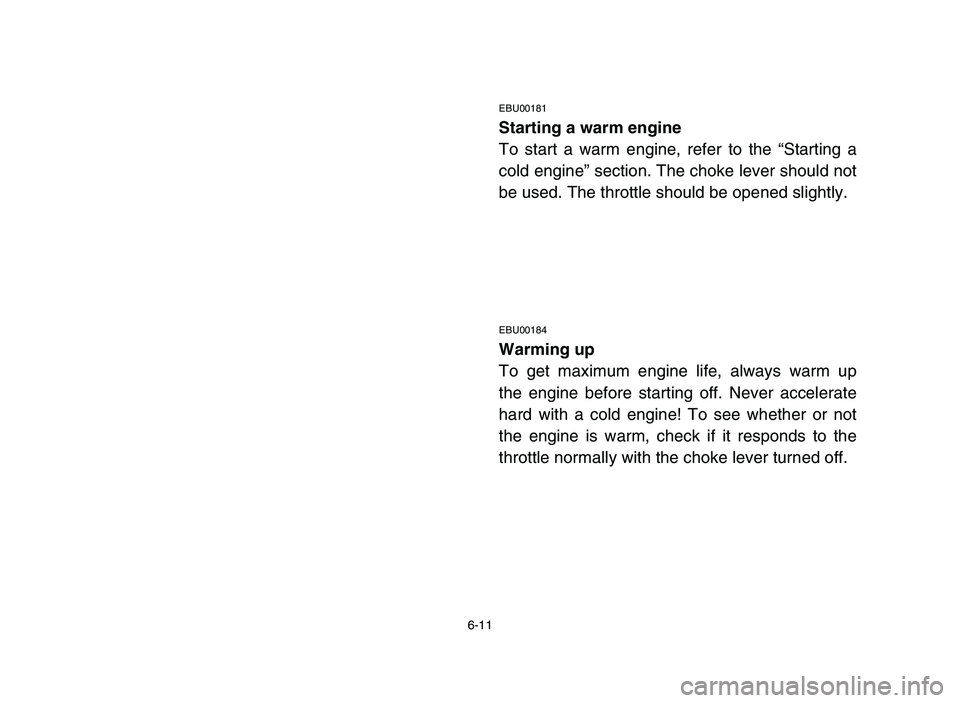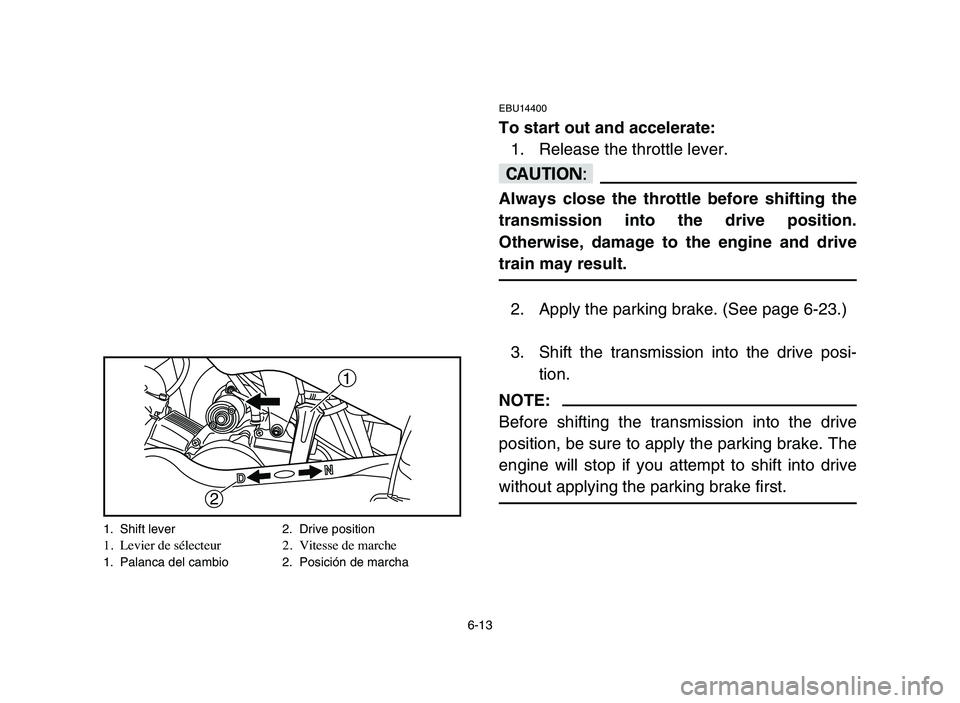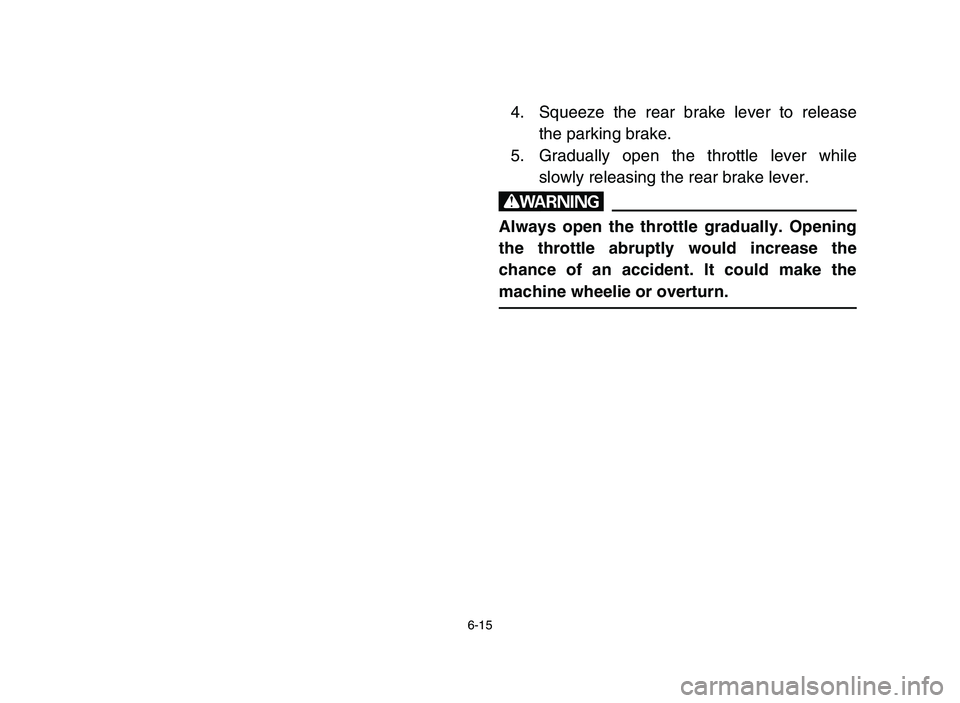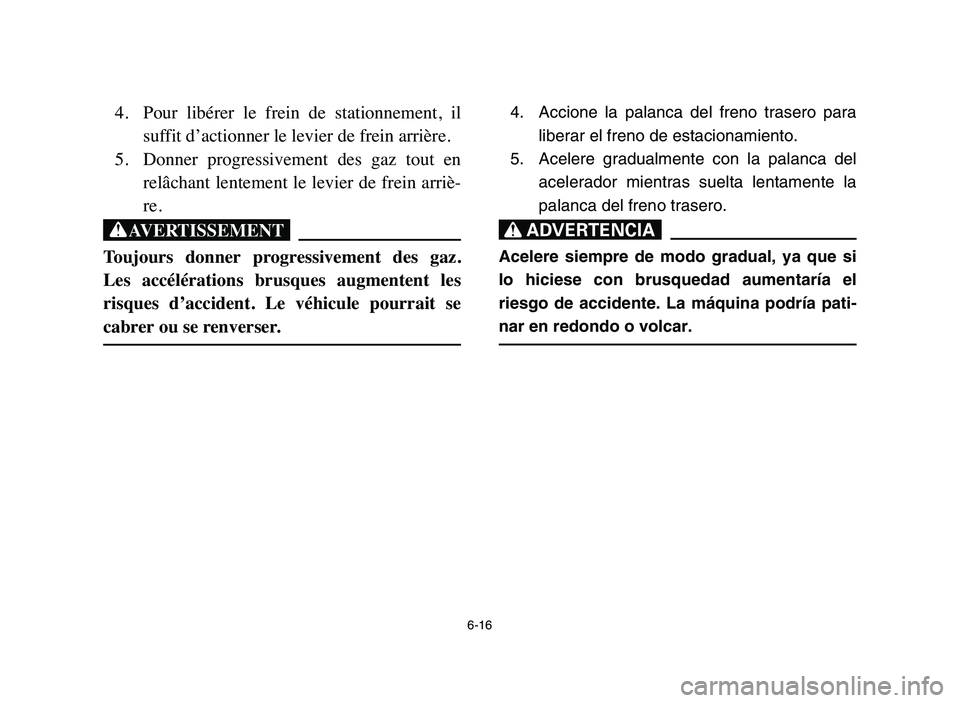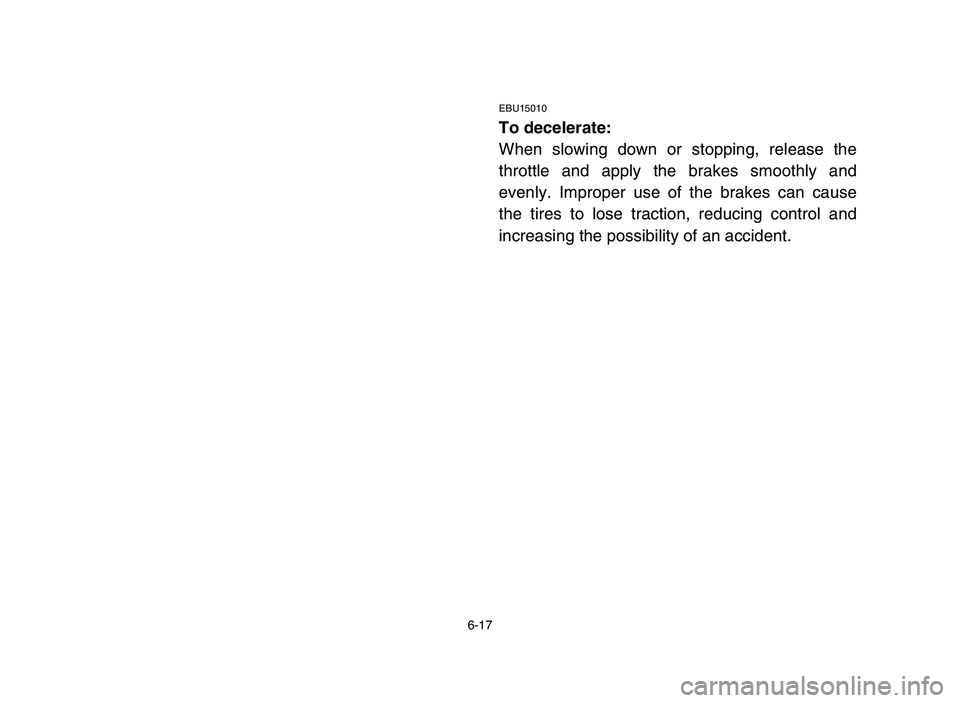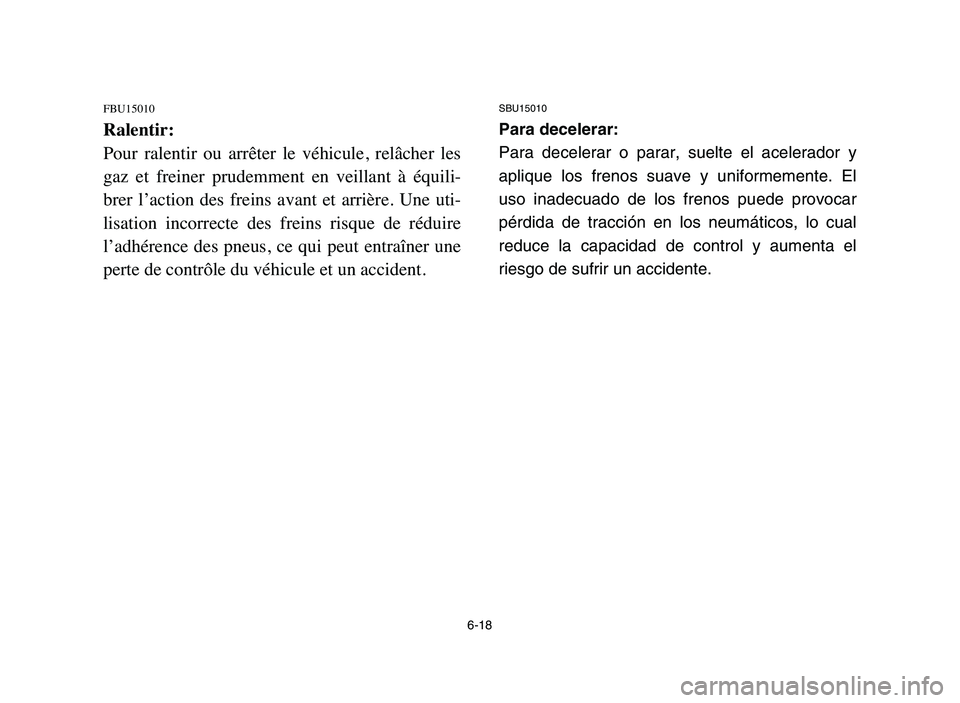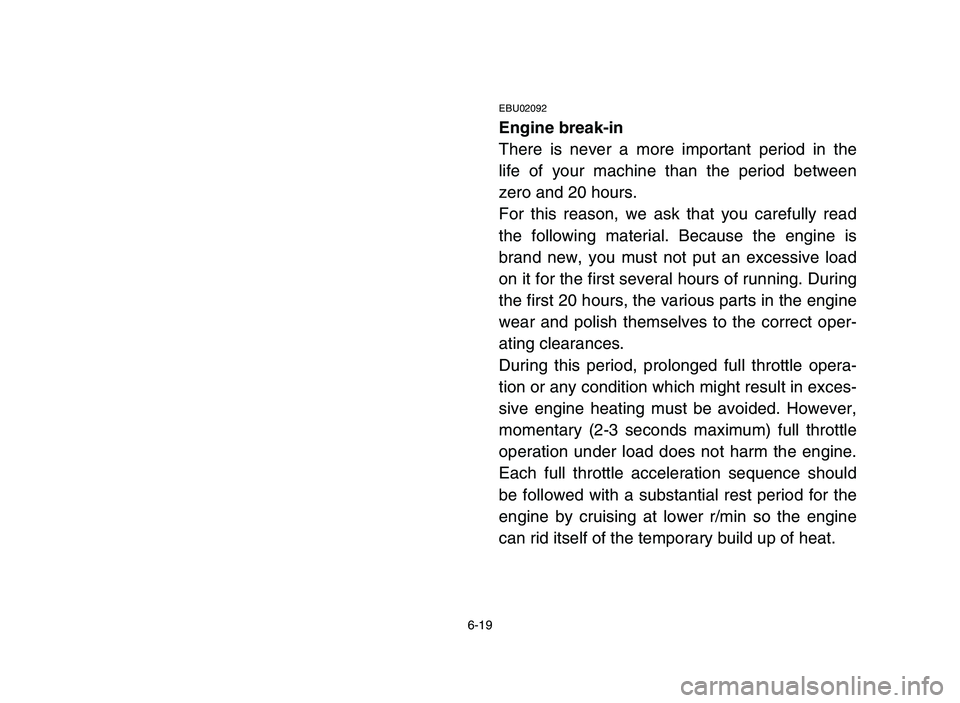YAMAHA YFM50R 2006 Manuale de Empleo (in Spanish)
YFM50R 2006
YAMAHA
YAMAHA
https://www.carmanualsonline.info/img/51/53734/w960_53734-0.png
YAMAHA YFM50R 2006 Manuale de Empleo (in Spanish)
Trending: lights, brake light, fuel reserve, suspension, clock, oil level, check engine
Page 141 of 350
6-10
8. Continuer à faire chauffer le moteur
jusqu’à ce que le ralenti soit régulier et
remettre le starter sur 3avant de démar-
rer.
fF
Lire attentivement la section “Rodage du
moteur” avant la première utilisation du
véhicule.
8. Deje que el motor se caliente hasta que el
ralentí mantenga un ralentí uniforme y
vuelva a poner la palanca del estrangula-
dor en la posición 3, antes de poner el
vehículo en movimiento.
bB
Antes de poner en marcha el motor por pri-
mera vez, consulte el apartado “Rodaje del
motor”.
5YF-9-62 6 2/23/05 6:54 PM Page 9
Page 142 of 350
6-11
EBU00181
Starting a warm engine
To start a warm engine, refer to the “Starting a
cold engine” section. The choke lever should not
be used. The throttle should be opened slightly.
EBU00184
Warming up
To get maximum engine life, always warm up
the engine before starting off. Never accelerate
hard with a cold engine! To see whether or not
the engine is warm, check if it responds to the
throttle normally with the choke lever turned off.
5YF-9-62 6 2/23/05 6:54 PM Page 10
Page 143 of 350
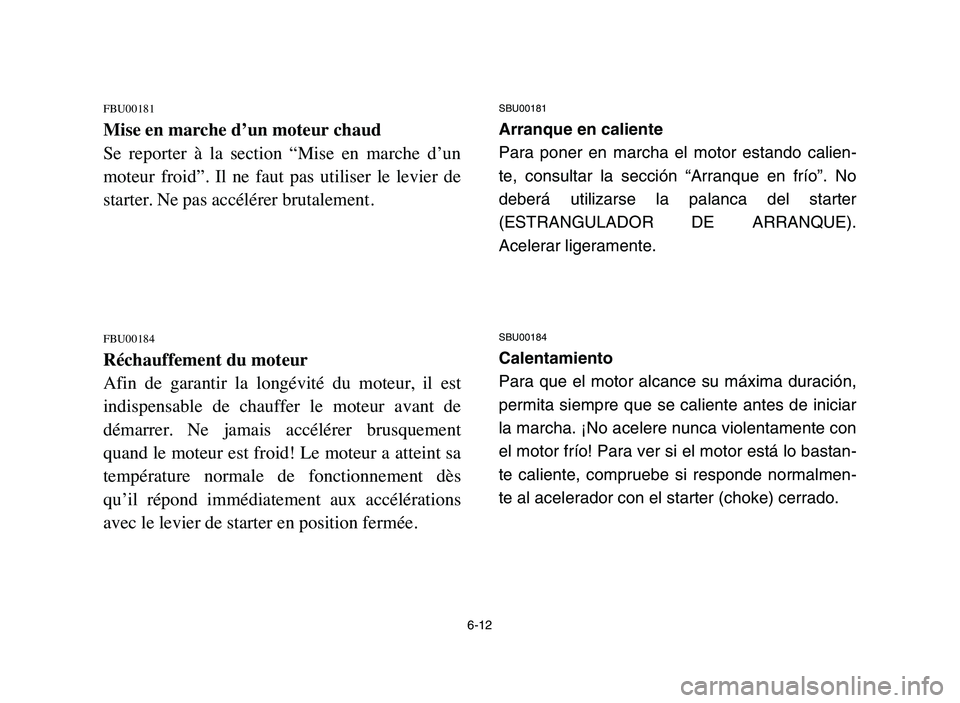
6-12
FBU00181
Mise en marche d’un moteur chaud
Se reporter à la section “Mise en marche d’un
moteur froid”. Il ne faut pas utiliser le levier de
starter. Ne pas accélérer brutalement.
FBU00184
Réchauffement du moteur
Afin de garantir la longévité du moteur, il est
indispensable de chauffer le moteur avant de
démarrer. Ne jamais accélérer brusquement
quand le moteur est froid! Le moteur a atteint sa
température normale de fonctionnement dès
qu’il répond immédiatement aux accélérations
avec le levier de starter en position fermée.
SBU00181
Arranque en caliente
Para poner en marcha el motor estando calien-
te, consultar la sección “Arranque en frío”. No
deberá utilizarse la palanca del starter
(ESTRANGULADOR DE ARRANQUE).
Acelerar ligeramente.
SBU00184
Calentamiento
Para que el motor alcance su máxima duración,
permita siempre que se caliente antes de iniciar
la marcha. ¡No acelere nunca violentamente con
el motor frío! Para ver si el motor está lo bastan-
te caliente, compruebe si responde normalmen-
te al acelerador con el starter (choke) cerrado.
5YF-9-62 6 2/23/05 6:54 PM Page 11
Page 144 of 350
6-13
1
2
1. Shift lever 2. Drive position1. Levier de sélecteur 2. Vitesse de marche1. Palanca del cambio 2. Posición de marcha
EBU14400
To start out and accelerate:
1. Release the throttle lever.
cC
Always close the throttle before shifting the
transmission into the drive position.
Otherwise, damage to the engine and drive
train may result.
2. Apply the parking brake. (See page 6-23.)
3. Shift the transmission into the drive posi-
tion.
NOTE:
Before shifting the transmission into the drive
position, be sure to apply the parking brake. The
engine will stop if you attempt to shift into drive
without applying the parking brake first.
5YF-9-62 6 2/23/05 6:54 PM Page 12
Page 145 of 350
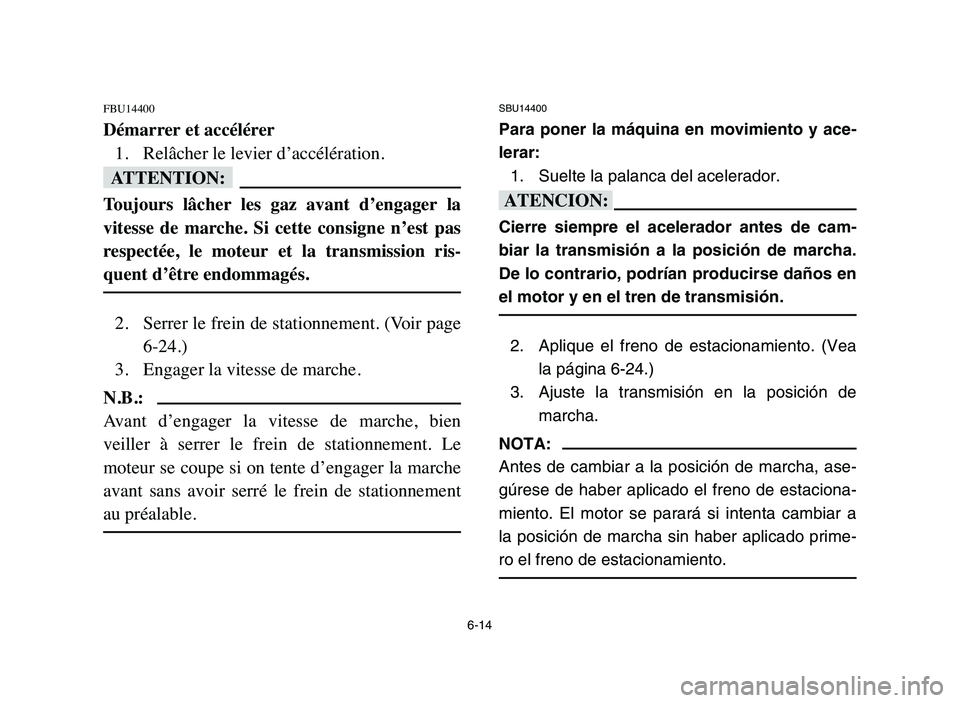
6-14
FBU14400
Démarrer et accélérer
1. Relâcher le levier d’accélération.
fF
Toujours lâcher les gaz avant d’engager la
vitesse de marche. Si cette consigne n’est pas
respectée, le moteur et la transmission ris-
quent d’être endommagés.
2. Serrer le frein de stationnement. (Voir page
6-24.)
3. Engager la vitesse de marche.
N.B.:
Avant d’engager la vitesse de marche, bien
veiller à serrer le frein de stationnement. Le
moteur se coupe si on tente d’engager la marche
avant sans avoir serré le frein de stationnement
au préalable.
SBU14400
Para poner la máquina en movimiento y ace-
lerar:
1. Suelte la palanca del acelerador.
bB
Cierre siempre el acelerador antes de cam-
biar la transmisión a la posición de marcha.
De lo contrario, podrían producirse daños en
el motor y en el tren de transmisión.
2. Aplique el freno de estacionamiento. (Vea
la página 6-24.)
3. Ajuste la transmisión en la posición de
marcha.
NOTA:
Antes de cambiar a la posición de marcha, ase-
gúrese de haber aplicado el freno de estaciona-
miento. El motor se parará si intenta cambiar a
la posición de marcha sin haber aplicado prime-
ro el freno de estacionamiento.
5YF-9-62 6 2/23/05 6:54 PM Page 13
Page 146 of 350
6-15
4. Squeeze the rear brake lever to release
the parking brake.
5. Gradually open the throttle lever while
slowly releasing the rear brake lever.
w
Always open the throttle gradually. Opening
the throttle abruptly would increase the
chance of an accident. It could make the
machine wheelie or overturn.
5YF-9-62 6 2/23/05 6:54 PM Page 14
Page 147 of 350
6-16
4. Pour libérer le frein de stationnement, il
suffit d’actionner le levier de frein arrière.
5. Donner progressivement des gaz tout en
relâchant lentement le levier de frein arriè-
re.
XG
Toujours donner progressivement des gaz.
Les accélérations brusques augmentent les
risques d’accident. Le véhicule pourrait se
cabrer ou se renverser.
4. Accione la palanca del freno trasero para
liberar el freno de estacionamiento.
5. Acelere gradualmente con la palanca del
acelerador mientras suelta lentamente la
palanca del freno trasero.
XR
Acelere siempre de modo gradual, ya que si
lo hiciese con brusquedad aumentaría el
riesgo de accidente. La máquina podría pati-
nar en redondo o volcar.
5YF-9-62 6 2/23/05 6:54 PM Page 15
Page 148 of 350
6-17
EBU15010
To decelerate:
When slowing down or stopping, release the
throttle and apply the brakes smoothly and
evenly. Improper use of the brakes can cause
the tires to lose traction, reducing control and
increasing the possibility of an accident.
5YF-9-62 6 2/23/05 6:54 PM Page 16
Page 149 of 350
6-18
FBU15010
Ralentir:
Pour ralentir ou arrêter le véhicule, relâcher les
gaz et freiner prudemment en veillant à équili-
brer l’action des freins avant et arrière. Une uti-
lisation incorrecte des freins risque de réduire
l’adhérence des pneus, ce qui peut entraîner une
perte de contrôle du véhicule et un accident.
SBU15010
Para decelerar:
Para decelerar o parar, suelte el acelerador y
aplique los frenos suave y uniformemente. El
uso inadecuado de los frenos puede provocar
pérdida de tracción en los neumáticos, lo cual
reduce la capacidad de control y aumenta el
riesgo de sufrir un accidente.
5YF-9-62 6 2/23/05 6:54 PM Page 17
Page 150 of 350
6-19
EBU02092
Engine break-in
There is never a more important period in the
life of your machine than the period between
zero and 20 hours.
For this reason, we ask that you carefully read
the following material. Because the engine is
brand new, you must not put an excessive load
on it for the first several hours of running. During
the first 20 hours, the various parts in the engine
wear and polish themselves to the correct oper-
ating clearances.
During this period, prolonged full throttle opera-
tion or any condition which might result in exces-
sive engine heating must be avoided. However,
momentary (2-3 seconds maximum) full throttle
operation under load does not harm the engine.
Each full throttle acceleration sequence should
be followed with a substantial rest period for the
engine by cruising at lower r/min so the engine
can rid itself of the temporary build up of heat.
5YF-9-62 6 2/23/05 6:54 PM Page 18
Trending: air condition, engine oil, fuse chart, gas type, technical data, low oil pressure, tire size
